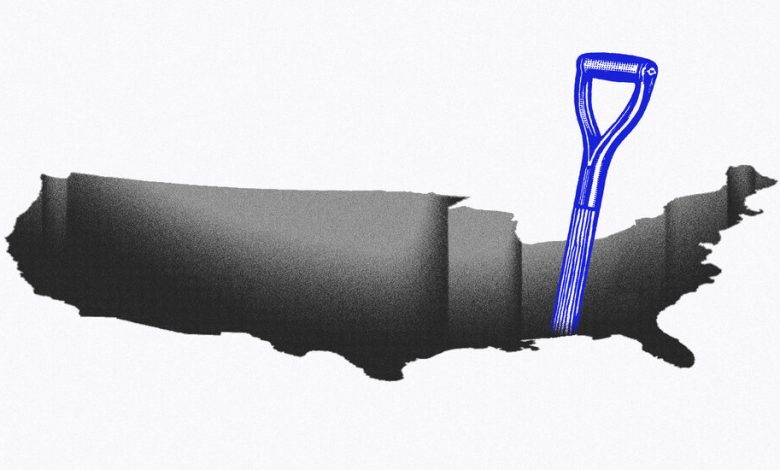We Still Need to Talk About Government Debt

I’m near-term slightly more optimistic but long-term pessimistic about the ability of the United States to deal with its budget problems. My uptick in optimism comes from a deal in Washington, while the pessimism comes from what I heard at an economics conference in San Antonio that I attended last weekend.
First, the good news: Facing the prospect of a partial government shutdown, House and Senate leaders announced on Sunday that they had agreed on a plan for the rest of this fiscal year that would put discretionary spending around the level that President Biden and then-speaker Kevin McCarthy agreed to last year.
Congress still has to turn that deal into passing four spending bills by a Jan. 19 deadline, and another eight of them by a second deadline on Feb. 2. “This is not going to be easy, to give the understatement of 2024,” said Senator Susan Collins of Maine, the top Republican on the Senate Appropriations Committee.
And there are a lot of problems with the deal, including a cut for the Internal Revenue Service — insisted upon by Republicans — that will make it easier for rich taxpayers to get away with cheating and reduce the resources available to the government.
But as flawed and fragile as the weekend deal is, it at least gives some hope that compromise over budget matters is possible.
What’s scary is that nothing that’s going on in Washington even begins to deal with the main problem, which is a chronic imbalance between revenue and spending that is causing the government debt to rise inexorably. If today’s fights over fairly small spending adjustments can bring the government to the brink of shutdown, what hope is there of achieving the far bigger changes in taxes and spending that will be required to shrink deficits meaningfully?
Out-of-control deficits were the topic of an illuminating session on Friday at that conference I mentioned, the American Economic Association annual meeting in San Antonio. This particular session featured Ellen Zentner, the chief U.S. economist of Morgan Stanley; Dana Peterson, the chief economist of the Conference Board, a business-supported research group; and Karen Dynan, a former chief economist of the Treasury Department who teaches at Harvard and is a senior fellow at the Peterson Institute for International Economics.
Here’s the problem: As this chart shows, the Congressional Budget Office projects today’s already huge deficits to widen steadily through 2053 (and beyond) under its baseline assumptions. The base line assumes no change in current law. Therefore, it assumes tax rates will rise when provisions of the 2017 Tax Cuts and Jobs Act expire in coming years. If the law changes and the tax cuts are extended, deficits will be even bigger than the ones in the chart.
The following chart shows what’s behind the projected increase in deficits: flat revenue coupled with rising spending.
Spending is growing as a share of gross domestic product for two main reasons: First, society is aging, so the cost of Social Security, Medicare and other programs for older Americans is rising. Second, interest payments are rising because, of course, the debt is growing.
Interest payments were manageable during the long period when the Federal Reserve suppressed interest rates to stimulate economic growth, but they have shot up since the Fed raised rates to quell inflation.
“I don’t think the path of the debt is sustainable under current policy,” Dynan said in San Antonio. She said that current deficits aren’t just a “pig in the python” — that is, a big lump that will gradually be digested. Unless something changes, she said, they will keep growing. I invite you to imagine a pig that keeps growing inside a python. And we’re the python.
“I don’t think lawmakers are doing us a service” by declaring some possible fixes off the table, Dynan said. President Biden has promised not to raise taxes on people earning less than $400,000 a year, and Republicans are determined to extend tax cuts for people earning even above that. I’ve argued that higher taxes have to be part of the budget fix.
Meanwhile, both parties have shied away from discussing changes to Social Security and Medicare. Dynan acknowledged that reforms in those programs are sensitive, but she said it’s important to learn more about how various suggested fixes would affect different segments of the population. Such changes don’t have to be regressive. One idea is to use general tax revenue to supplement payroll taxes. Another is to raise the normal retirement age for Social Security, but expand access to the disability safety net so blue-collar workers who can’t do their jobs into their late 60s wouldn’t be penalized.
Peterson, of the Conference Board, said that it’s unrealistic to solve the deficit problem in a decade, but important to “bend the curve” so deficits come down over 20 to 30 years. She recommended that Congress appoint a blue-ribbon commission to come up with a plan for deficit reduction that could earn bipartisan support. The goal: to reduce federal debt held by the public from today’s 98 percent to around 70 percent over the next few decades. In November I wrote about two bipartisan bills to establish fiscal commissions.
Zentner, who grew up in Texas and was thus speaking on her home turf, pointed out that the government doesn’t need to start running surpluses to make up for years of running deficits. As the economy grows, tax revenue tends to grow with it, and the existing load of debt becomes more affordable. The government can even afford to run small deficits and still grow its way out of its debt problem. But she presented charts showing that today’s deficits are far above what’s sustainable.
Deficits came up in other sessions at the economics conference. James Hines, who teaches at the University of Michigan’s law school and economics department and serves as the research director of the business school’s Office of Tax Policy Research, said that by 2029, federal debt held by the public as a share of G.D.P. will surpass the record set at the end of World War II. Back then, it shrank quickly, owing to a postwar economic boom and inflation. This time, it won’t.
Hines said he’s not so worried that rising deficits will cause a crisis. More likely, he said, they will slowly erode American power as the nation is forced to cut back on research and development, investment and military spending. “Why is the United States rich to begin with?” he asked. It’s because “we’ve been doing capitalism better than a lot of other places,” he said. “If we let that erode, you’re starting to undermine the sources of your wealth.”
Dynan made a similar point. There is no threshold for debt above which “hair goes on fire,” she said. She said she almost wished there were, because it might galvanize people into action.
Outlook: Tim Duy
The Federal Reserve might cut interest rates as aggressively as it raised them, according to Tim Duy, the chief U.S. economist at SGH Macro Advisors. In his Monday newsletter, he wrote that once the Federal Reserve chair, Jerome Powell, decided the Fed needed to raise rates sharply to curb inflation, “he moved quickly.” Now that inflation appears to be coming under control, the Fed could unwind those increases just as quickly, Duy wrote. “The urgency will only increase if the Fed decides it is chasing low inflation like it was chasing high inflation two years ago, or if it perceives a threat to the employment mandate.”
Quote of the Day
“Fifty-six percent of the economically most impactful technologies come from just two U.S. locations, Silicon Valley and the Northeast Corridor.”
— Aakash Kalyani, Nicholas Bloom, Marcela Carvalho, Tarek Hassan, Josh Lerner and Ahmed Tahoun, “The Diffusion of New Technologies,” revised working paper (Oct. 30, 2023)





